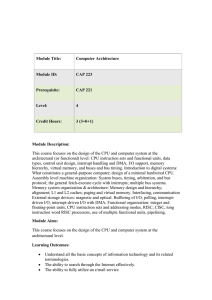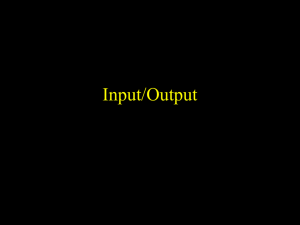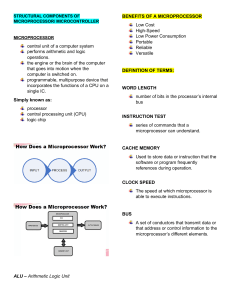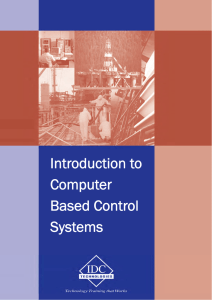Document 15592682
advertisement
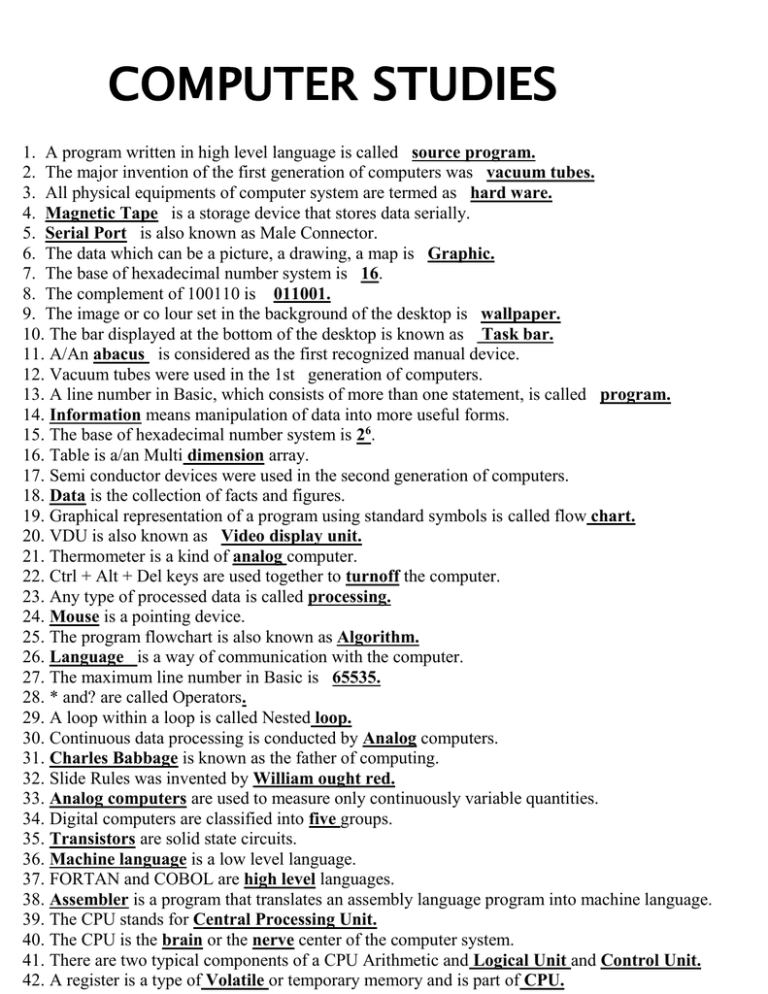
1. A program written in high level language is called source program. 2. The major invention of the first generation of computers was vacuum tubes. 3. All physical equipments of computer system are termed as hard ware. 4. Magnetic Tape is a storage device that stores data serially. 5. Serial Port is also known as Male Connector. 6. The data which can be a picture, a drawing, a map is Graphic. 7. The base of hexadecimal number system is 16. 8. The complement of 100110 is 011001. 9. The image or co lour set in the background of the desktop is wallpaper. 10. The bar displayed at the bottom of the desktop is known as Task bar. 11. A/An abacus is considered as the first recognized manual device. 12. Vacuum tubes were used in the 1st generation of computers. 13. A line number in Basic, which consists of more than one statement, is called program. 14. Information means manipulation of data into more useful forms. 15. The base of hexadecimal number system is 26. 16. Table is a/an Multi dimension array. 17. Semi conductor devices were used in the second generation of computers. 18. Data is the collection of facts and figures. 19. Graphical representation of a program using standard symbols is called flow chart. 20. VDU is also known as Video display unit. 21. Thermometer is a kind of analog computer. 22. Ctrl + Alt + Del keys are used together to turnoff the computer. 23. Any type of processed data is called processing. 24. Mouse is a pointing device. 25. The program flowchart is also known as Algorithm. 26. Language is a way of communication with the computer. 27. The maximum line number in Basic is 65535. 28. * and? are called Operators. 29. A loop within a loop is called Nested loop. 30. Continuous data processing is conducted by Analog computers. 31. Charles Babbage is known as the father of computing. 32. Slide Rules was invented by William ought red. 33. Analog computers are used to measure only continuously variable quantities. 34. Digital computers are classified into five groups. 35. Transistors are solid state circuits. 36. Machine language is a low level language. 37. FORTAN and COBOL are high level languages. 38. Assembler is a program that translates an assembly language program into machine language. 39. The CPU stands for Central Processing Unit. 40. The CPU is the brain or the nerve center of the computer system. 41. There are two typical components of a CPU Arithmetic and Logical Unit and Control Unit. 42. A register is a type of Volatile or temporary memory and is part of CPU. 43. Bus is a set of wires that is used as a communication path. 44. A collection of wires connecting the CPU with main memory is called address bus. 45. A physical connection between the CPU and other devices with the computer is called Control bus. 46. The number of wires in data bus determines the speed of data traveling. 47. Memory is the storage device inside your computer where data resides. 48. There are two types of memory internal memory and external memory. 49. RAM is tempory or volatile memory. 50. ROM is permanent or non volatile memory. 51. The external memory is also termed as secondary storage. 52. Secondary storages include floppy disks, hard disks, magnetic tapes, CD-ROMs etc. 53. Input devices are used to enter the data into the system. 54. The output devices present the outcome of the computations from the system. 55. A port is a socket at the back of a computer used to plug in various devices. 56. There are two types of ports namely serial ports and parallel ports. 57. Slow devices are connected with the serial port. True or false Registers are non – volatile memory. (True) RPM stands for Rotation per Minute. (True) Ram is an external storage. (False) The processed form of data is known as string. (False) As operating system is a set of programs. (True) Any old disk cannot be formatted. (False) WHILE –WEND is a post –test loop. (True) The flowchart is always prepared after writing a program. (True) Data processing is the manipulation of data into a more useful form. (False) Mark –I is the first digital computer. (True)

